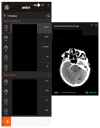Implementation of Machine Learning Software on the Radiology Worklist Decreases Scan View Delay for the Detection of Intracranial Hemorrhage on CT
- PMID: 34201775
- PMCID: PMC8301803
- DOI: 10.3390/brainsci11070832
Implementation of Machine Learning Software on the Radiology Worklist Decreases Scan View Delay for the Detection of Intracranial Hemorrhage on CT
Abstract
Background and purpose: Prompt identification of acute intracranial hemorrhage on CT is important. The goal of this study was to assess the impact of artificial intelligence software for prioritizing positive cases.
Materials and methods: Cases analyzed by Aidoc (Tel Aviv, Israel) software for triaging acute intracranial hemorrhage cases on non-contrast head CT were retrospectively reviewed. The scan view delay time was calculated as the difference between the time the study was completed on PACS and the time the study was first opened by a radiologist. The scan view delay was stratified by scan location, including emergency, inpatient, and outpatient. The scan view delay times for cases flagged as positive by the software were compared to those that were not flagged.
Results: A total of 8723 scans were assessed by the software, including 6894 cases that were not flagged and 1829 cases that were flagged as positive. Although there was no statistically significant difference in the scan view time for emergency cases, there was a significantly lower scan view time for positive outpatient and inpatient cases flagged by the software versus negative cases, with a reduction of 604 min on average, 90% in the scan view delay (p-value < 0.0001) for outpatients, and a reduction of 38 min on average, and 10% in the scan view delay (p-value <= 0.01) for inpatients.
Conclusion: The use of artificial intelligence triage software for acute intracranial hemorrhage on head CT scans is associated with a significantly shorter scan view delay for cases flagged as positive than cases not flagged among outpatients and inpatients at an academic medical center.
Keywords: CT; artificial intelligence; head; hemorrhage; report; scan view delay.
Conflict of interest statement
The author declares no conflict of interests.
Figures


Similar articles
-
Analysis of head CT scans flagged by deep learning software for acute intracranial hemorrhage.Neuroradiology. 2020 Mar;62(3):335-340. doi: 10.1007/s00234-019-02330-w. Epub 2019 Dec 11. Neuroradiology. 2020. PMID: 31828361
-
Real world validation of an AI-based CT hemorrhage detection tool.Front Neurol. 2023 Aug 3;14:1177723. doi: 10.3389/fneur.2023.1177723. eCollection 2023. Front Neurol. 2023. PMID: 37602253 Free PMC article.
-
Assessment of commercially available artificial intelligence software for differentiating hemorrhage from contrast on head CT following thrombolysis for ischemic stroke.Front Neurol. 2025 Mar 4;16:1458142. doi: 10.3389/fneur.2025.1458142. eCollection 2025. Front Neurol. 2025. PMID: 40103936 Free PMC article.
-
[Value of serial CT scanning and intracranial pressure monitoring for detecting new intracranial mass effect in severe head injury patients showing lesions type I-II in the initial CT scan].Neurocirugia (Astur). 2005 Jun;16(3):217-34. Neurocirugia (Astur). 2005. PMID: 16007322 Review. Spanish.
-
Review of deep learning algorithms for the automatic detection of intracranial hemorrhages on computed tomography head imaging.J Neurointerv Surg. 2021 Apr;13(4):369-378. doi: 10.1136/neurintsurg-2020-017099. Epub 2021 Jan 21. J Neurointerv Surg. 2021. PMID: 33479036
Cited by
-
Sociodemographic biases in a commercial AI model for intracranial hemorrhage detection.Emerg Radiol. 2024 Oct;31(5):713-723. doi: 10.1007/s10140-024-02270-w. Epub 2024 Jul 22. Emerg Radiol. 2024. PMID: 39034382
-
Systematic Review of Artificial Intelligence for Abnormality Detection in High-volume Neuroimaging and Subgroup Meta-analysis for Intracranial Hemorrhage Detection.Clin Neuroradiol. 2023 Dec;33(4):943-956. doi: 10.1007/s00062-023-01291-1. Epub 2023 Jun 1. Clin Neuroradiol. 2023. PMID: 37261453 Free PMC article.
-
Artificial intelligence CAD tools in trauma imaging: a scoping review from the American Society of Emergency Radiology (ASER) AI/ML Expert Panel.Emerg Radiol. 2023 Jun;30(3):251-265. doi: 10.1007/s10140-023-02120-1. Epub 2023 Mar 14. Emerg Radiol. 2023. PMID: 36917287 Free PMC article.
-
Can Artificial Intelligence Be Applied to Diagnose Intracerebral Hemorrhage under the Background of the Fourth Industrial Revolution? A Novel Systemic Review and Meta-Analysis.Int J Clin Pract. 2022 Feb 24;2022:9430097. doi: 10.1155/2022/9430097. eCollection 2022. Int J Clin Pract. 2022. PMID: 35685590 Free PMC article.
-
Diagnostic Accuracy of Deep Learning for Intracranial Hemorrhage Detection in Non-Contrast Brain CT Scans: A Systematic Review and Meta-Analysis.J Clin Med. 2025 Mar 30;14(7):2377. doi: 10.3390/jcm14072377. J Clin Med. 2025. PMID: 40217828 Free PMC article. Review.
References
-
- Carter J.A., Curry W. Intracerebral Hemorrhage: Pathophysiology and Management for Generalists. Hosp. Med. Clin. 2017;6:95–111. doi: 10.1016/j.ehmc.2016.08.002. - DOI
-
- McDonald R.J., Schwartz K.M., Eckel L.J., Diehn F.E., Hunt C.H., Bartholmai B.J., Erickson B.J., Kallmes D.F. The Effects of Changes in Utilization and Technological Advancements of Cross-Sectional Imaging on Radiologist Workload. Acad. Radiol. 2015;22:1191–1198. doi: 10.1016/j.acra.2015.05.007. - DOI - PubMed
-
- Sasank Chilamkurthy B., Rohit Ghosh B., Swetha Tanamala M., Mustafa Biviji D.N.B., Campeau N.G., Venugopal V.K., Mahajan V., Rao P., Warier P. Deep learning algorithms for detection of critical findings in head CT scans: A retrospective study. Lancet. 2018;392:2388–2396. doi: 10.1016/S0140-6736(18)31645-3. - DOI - PubMed
LinkOut - more resources
Full Text Sources

